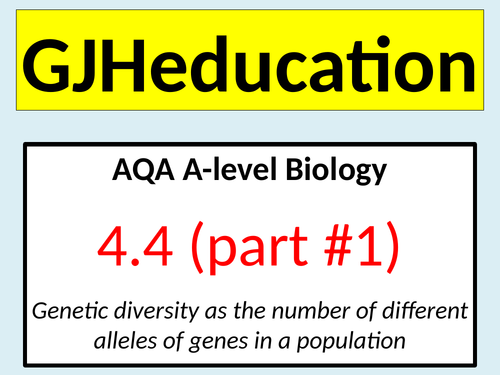





This fully-resourced lesson describes genetic diversity as the number of genes in a population and explains how this is increased by polymorphic gene loci. The engaging PowerPoint and accompanying differentiated resources have been primarily designed to cover the first part of point 4.4 of the AQA A-level Biology specification but also introduces inheritance and codominance so that students are prepared for these sub-topics when covering topic 7 in the following year.
In order to understand that 2 or more alleles can be found at a gene loci, students need to be confident with genetic terminology, so the start of the lesson focuses on key terms including gene, locus, allele, recessive, genotype and phenotype. A number of these will have been met at GCSE, as well as during the earlier lessons in topic 4 when considering meiosis, so a quick quiz competition is used to check on their recall of the meanings of these terms. The CFTR gene is then used as an example to demonstrate how 2 alleles results in 2 different phenotypes and therefore genetic diversity. Moving forwards, students will discover that more than 2 alleles can be found at a locus and they are challenged to work out genotypes and phenotypes for a loci with 3 alleles (shell colour in snails) and 4 alleles (coat colour in rabbits). At this point, the students are introduced to codominance and again they are challenged to apply their understanding to a new situation by working out the number of phenotypes in the inheritance of blood groups. The lesson concludes with a brief consideration of the HLA gene loci, which is the most polymorphic loci in the human genome, and students are challenged to consider how this sheer number of alleles can affect the chances of tissue matches in organ transplantation.
Get this resource as part of a bundle and save up to 39%
A bundle is a package of resources grouped together to teach a particular topic, or a series of lessons, in one place.
Topic 4: Genetic information, variation and relationships between organisms (AQA A-level Biology)
Every one of the lessons included in this bundle is detailed, engaging and fully-resourced, and has been written to cover the content as detailed in topic 4 of the AQA A-level Biology specification. The wide range of activities will maintain engagement whilst supporting the explanations of the content to allow the students to build a deep understanding of genetic information, variation and relationships between organisms. The following 17 lessons covering the 7 sub-topics are included in this bundle: 4.1: DNA, genes and chromosomes * DNA in prokaryotes and eukaryotes * Genes 4.2: DNA and protein synthesis * Genome, proteome and the structure of RNA * Transcription and splicing * Translation 4.3: Genetic diversity can arise as a result of mutation or during meiosis * The genetic code * Gene mutations * Chromosome mutations * Meiosis 4.4: Genetic diversity and adaptation * Genetic diversity * Natural selection * Adaptations 4.5: Species and taxonomy * Species and taxonomy 4.6: Biodiversity within a community * Biodiversity within a community * Calculating an index of diversity * The balance between conservation and farming 4.7: Investigating diversity * Investigating diversity * Interpreting mean values and the standard deviation If you would like to sample the quality of the lessons in this bundle, then download the DNA in prokaryotes and eukaryotes, structure of RNA, gene mutations, natural selection and standard deviation lessons as these have been uploaded for free
Topics 4.4 - 4.7 (AQA A-level Biology)
These 7 lessons are highly detailed and are filled with a wide range of tasks that will engage the students whilst covering the following specification points in topics 4.4, 4.5, 4.6 and 4.7 of the AQA A-level Biology specification: 4.4 Genetic diversity as the number of different alleles of genes in a population and a factor enabling natural selection to occur The principles of natural selection in the evolution of populations Directional and stabilising selection Natural selection results in anatomical, physiological or behavioural adaptations 4.5 Two organisms belong to the same species if they are able to produce fertile offspring The taxonomic hierarchy comprising domain, kingdom, phylum, class, order, family, genus and species The use of the binomial name to identify species 4.6 Biodiversity can relate to a range of habitats Species richness Calculating an index of diversity 4.7 Investigating genetic diversity with, or between species, by comparing observable characteristics or nucleic acids and the structure of proteins Calculating and interpreting the mean and standard deviation If you download the natural selection and standard deviation lessons which have been shared for free then you will be able to see the quality of lessons included in this bundle
Something went wrong, please try again later.
Amazing. This is one of the best resources I have bought
Report this resourceto let us know if it violates our terms and conditions.
Our customer service team will review your report and will be in touch.